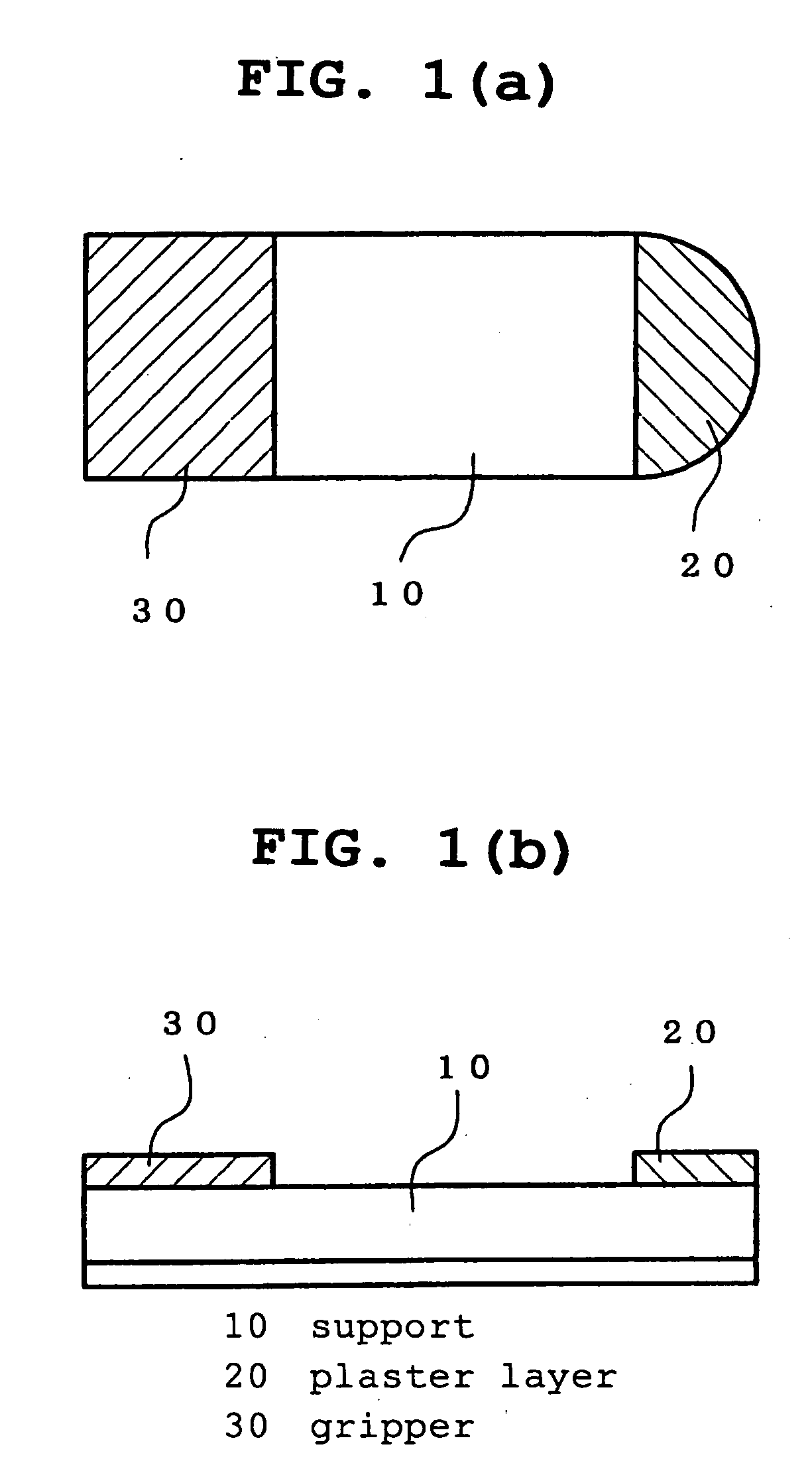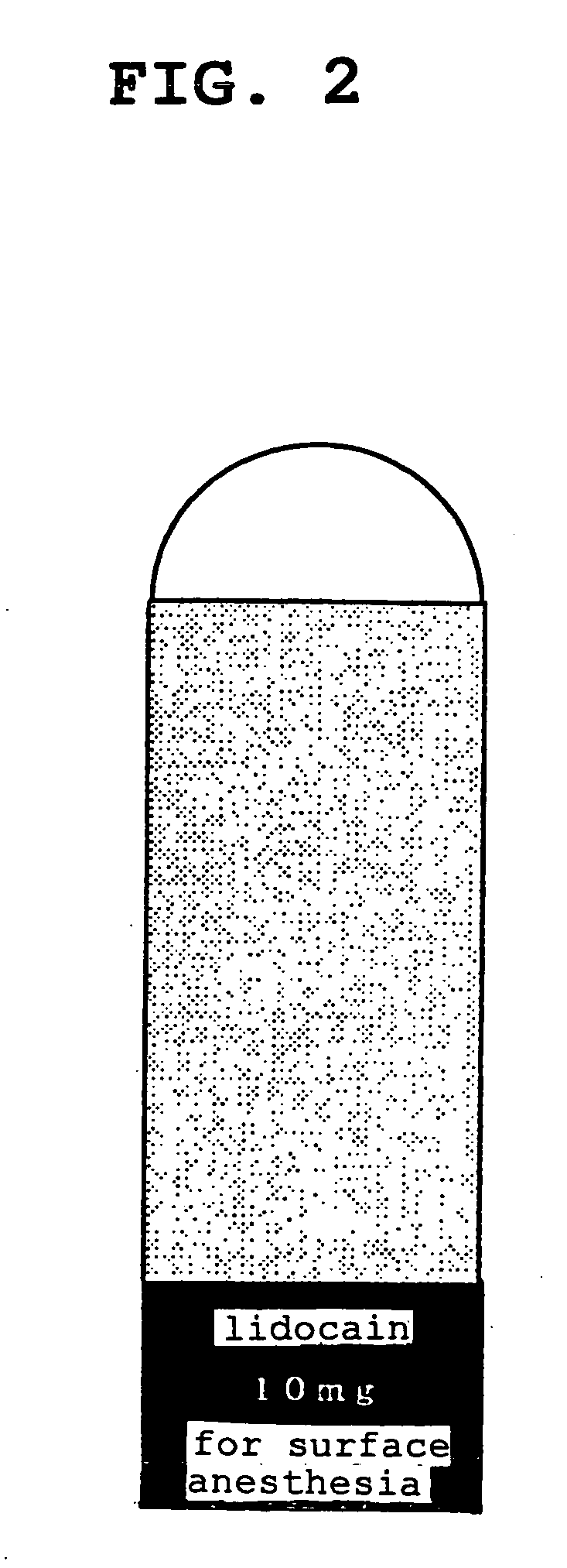Topical anesthetic preparation for pretreatment for upper gastrointestinal endoscopy
a technology for gastrointestinal endoscopy and topical anesthetic, which is applied in the direction of bandages, dressings, drug compositions, etc., can solve the problems of difficult to determine from the outside if, extreme bitter taste of anesthetic, and difficult to determine from the outside, so as to achieve the effect of easy knowing the preparation used and highly efficient use of anestheti
- Summary
- Abstract
- Description
- Claims
- Application Information
AI Technical Summary
Benefits of technology
Problems solved by technology
Method used
Image
Examples
example 1
[0067] A polyethylene terephthalate film (thickness 6 μm) was coated with a mixed solution of a polyester urethanepolyol resin (72 parts), aromatic polyisocyanate (8 parts) and ethyl acetate (240 parts) and dried to form a dry laminate adhesive layer having a thickness of 10 μm. A spunlace non-woven fabric (mass 90 g / m2, thickness about 420 μm, stiffness 115 mm) prepared from a composite fiber comprising 50% polyethylene terephthalate and 50% polypropylene having an about triangle section having a bottom side of 5 μm and height 10 μm was laminated on this adhesive layer. Then, this laminate was cut into a rectangle (short side 30 mm, long side 80 mm) to give a support sheet 10. Separately, a mixed solution of acrylic acid / octyl acrylate copolymer (40 parts) and lidocain (60 parts) in ethyl acetate was coated on a 75 μm thick polyethylene terephthalate film that had undergone a silicon release treatment in an amount to achieve 31 g / m2 after drying and dried to give a plaster sheet la...
example 2
[0068] In the same manner as in Example 1, a rectangular support sheet 10 (short side 20 mm, long side 80 mm) was obtained. A mixed solution of acrylic acid / octyl acrylate copolymer (40 parts) and lidocain (60 parts) in ethyl acetate was coated on a 75 μm thick polyethylene terephthalate film that had undergone a silicon release treatment in an amount to achieve 70 g / m2 after drying and dried to give a plaster sheet layer 20. This plaster layer 20 was cut out in a semicircle having a radius of 10 mm, and laminated on the surface of a non-woven fabric on one end of the support 10 with the circular arc facing outside. The corner of the support was cut off along the shape of the circular arc of the plaster layer 20. A polyethylene terephthalate film (length 20 mm, width 30 mm, thickness 50 μm), on which drug name, dose of drug and use were printed in white letters on a green base by gravure printing, was laminated on the surface of a non-woven fabric on the other end of the support 10 ...
example 3
[0069] In the same manner as in Example 1, a rectangular support sheet 10 (short side 40 mm, long side 100 mm) was obtained. A mixed solution of acrylic acid / octyl acrylate copolymer (40 parts) and lidocain (60 parts) in ethyl acetate was coated on a 75 μm thick polyethylene terephthalate film that had undergone a silicon release treatment in an amount to achieve 18 g / m2 after drying and dried to give a plaster sheet layer 20. This plaster layer 20 was cut out in a semicircle having a radius of 20 mm, and laminated on the surface of a non-woven fabric on one end of the support 10 with the circular arc facing outside. The corner of the support was cut off along the shape of the circular arc of the plaster layer 20. A polyethylene terephthalate film (length 20 mm, width 40 mm, thickness 50 μm), on which drug name, dose of drug and use were printed in white letters on an orange base, was laminated on the surface of a non-woven fabric on the other end of the support 10 by a method simil...
PUM
| Property | Measurement | Unit |
|---|---|---|
| angle | aaaaa | aaaaa |
| length | aaaaa | aaaaa |
| thickness | aaaaa | aaaaa |
Abstract
Description
Claims
Application Information
 Login to view more
Login to view more - R&D Engineer
- R&D Manager
- IP Professional
- Industry Leading Data Capabilities
- Powerful AI technology
- Patent DNA Extraction
Browse by: Latest US Patents, China's latest patents, Technical Efficacy Thesaurus, Application Domain, Technology Topic.
© 2024 PatSnap. All rights reserved.Legal|Privacy policy|Modern Slavery Act Transparency Statement|Sitemap


